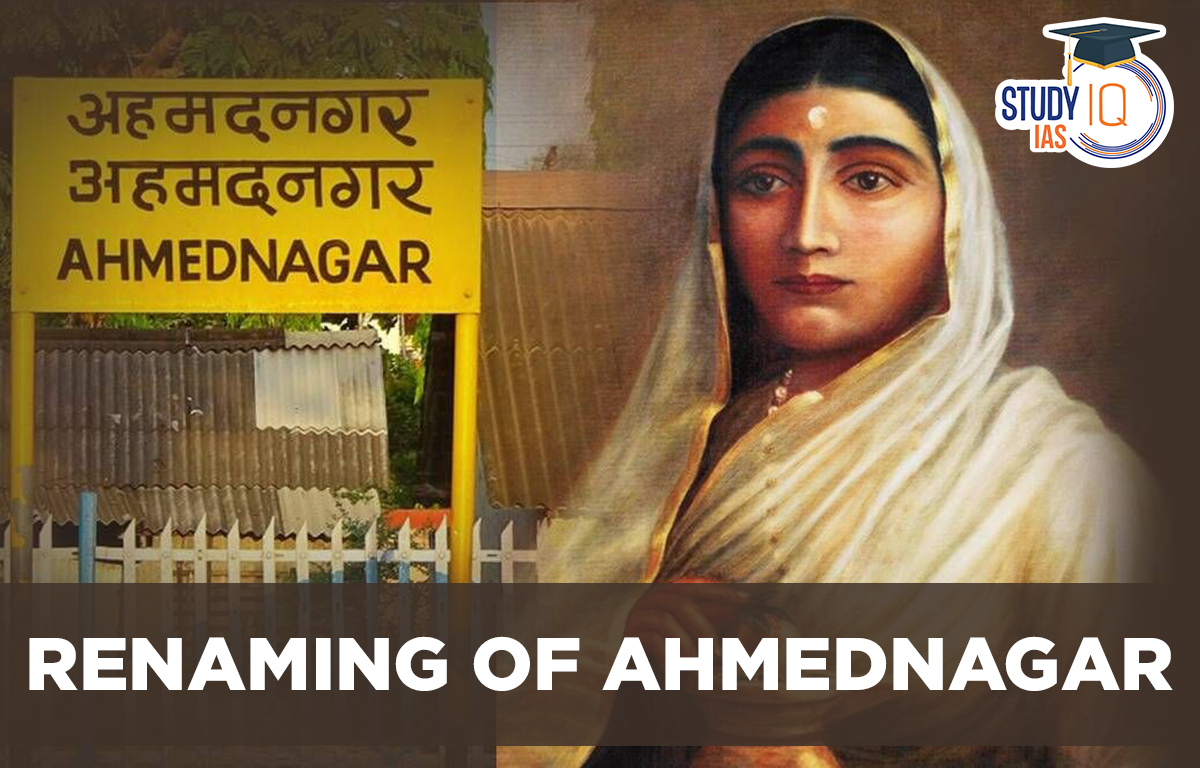Table of Contents
Context: The Maharashtra Government has asked the district administration to submit a proposal to Renaming of Ahmednagar as ‘Punyashlok Ahilyadevi Nagar’, after the 18th century Malwa queen, Ahilyabai Holkar.
Renaming of Ahmednagar Background
- In August 2022, the Maharashtra Assembly unanimously passed two separate resolutions to rename Aurangabad as Chhatrapati Sambhaji Nagar and rename Osmanabad as Dharashiv.
About Ahmednagar District

- Location: Ahmednagar district is situated in the middle of western Maharashtra.
- Important rivers: Godavari and Bhima Rivers.
- Climate: Hot semi-arid climate and the district known mainly as a drought prone area.
- Important crops:
- Rabbi Jowar, bajra, groundnut, monastery, soybean and moong in Kharif season.
- Jawar, wheat and gram in Rabi season.
- Sugarcane is the major cash crop of the district.
- Ahmednagar district is still known for its identity as a leader in the cooperative sector.
- History:
- The district has been a part of some prominent kingdoms, starting from 240B.C, when the vicinity is mentioned in the reference to the Mauryan Emperor Ashok.
- The Rashtrakuta Dynasty, the Western Chalukyas, and then the Delhi Sultanate ruled over the region in the medieval period.
- During Delhi Sultanate period, the rule was not direct, and a revolt by Afghan soldier Alladin Hasan Gangu led to the establishment of the Bahmani kingdom in the Deccan.
- After some time, Ahmednagar (then known as Nizamshahi) became one of the five independent kingdoms to emerge from that empire.
How did Ahmednagar First get its Name?
- In 1486, Malik Ahmad Nizam Shah became the Bahmani Sultanate’s Prime Minister.
- He fought back an attempt by the king to dislodge him from power, and defeated the army of the Bahamani kingdom near Ahmednagar in May 1490.
- Finally, in 1494 he laid the foundation of a city close to where he defeated the army, on the left bank of Sina River, and named it after himself: Ahmednagar.
Who was Ahilyabai Holkar (1725 –1795)?

- Birth: Born in Chondi village of Ahmednagar to the village head Mankoji Shinde, on May 31, 1725, Ahilyabai was one of the few women rulers of Medieval India.
- Emergence as a ruler:
- When she was eight years old, Malhar Rao Holkar, the army commander to Peshwa Bajirao, is believed to have spotted her at a temple service in Chondi.
- Impressed by her devotion and character, he decided to get his son, Khande Rao, married to her.
- Ahilyabai took control of Malwa after her husband’s death in the Battle of Kumbher against the king of Bharatpur in 1754.
- She excelled at administrative and military strategies under the guidance of her father-in-law.
- After the death of her father-in-law and son a few years later, she petitioned the Peshwa to become the ruler, backed by the support of her army.
- Significant Contributions:
- Peace and stability in Malwa: During her reign, Malwa was never once attacked, when at that time the whole of Central India was facing a power struggle. Under her rule, Malwa remained an oasis of stability and peace.
- The city of Maheshwar: Under her rule, the city of Maheshwar became a literary, musical, artistic and industrial centre, and she helped establish a textile industry there, which is now home to the famous Maheshwari saris.
- Temple building: Her role in the restoration of Hindu temples is often emphasized.
- From Gangotri to Rameshwaram, and from Dwarka to Gaya, she spent money on rebuilding temples destroyed under the Mughal rule.
- In 1780, she had the Kashi Vishwanath temple in Varanasi rebuilt, nearly a century after Mughal king Aurangzeb ordered its destruction.
- The Somnath temple, repeatedly destroyed over centuries, was restored in 1783 by the Maratha confederates, with significant contributions from Ahilyabai.
- Apart from temple building, she also supported the construction of resting lodges for travelers, and of public ghats.
- John Keay, the British historian, gave Ahilyabai Holkar the title of ‘The Philosopher Queen’. During her reign, she spread the message of dharma and promoted industrialisation in the 18th century.


 Payments Regulatory Board (PRB)
Payments Regulatory Board (PRB)
 OPSC OCS Notification 2026 Out: Apply On...
OPSC OCS Notification 2026 Out: Apply On...
 UPPSC LT Grade Admit Card 2025 Out @upps...
UPPSC LT Grade Admit Card 2025 Out @upps...

























